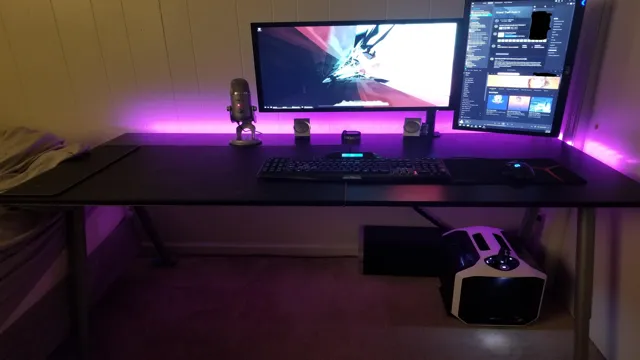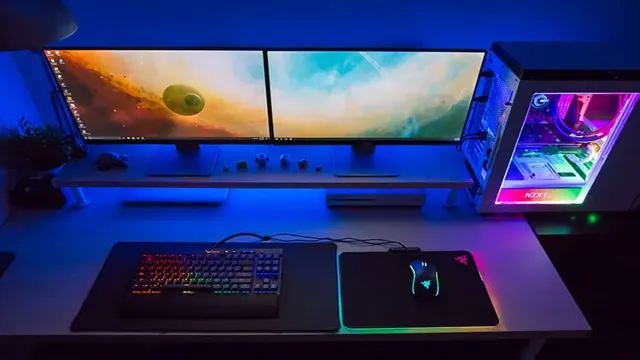Have you ever felt like your computer screen is just too small to efficiently get your work done? Or do you want to improve your gaming experience with a wider display? Whatever your reason may be, setting up dual monitors can greatly enhance your productivity and entertainment. Essentially, dual monitors allow you to expand your computer’s screen real estate by adding a second monitor to your setup. This means you can have multiple applications running simultaneously and switch between them with ease.
It’s like having a wider desk where you can spread out all your work materials. In this blog, we will guide you step by step on how to set up dual monitors and enjoy the benefits of having two screens.
What You Need
Setting up a dual monitor with both your GPU and motherboard can be an excellent way to expand your workspace and boost your productivity. To do this, you will need a few essential things. First, your computer must have both a GPU and integrated graphics.
Next, check if your motherboard has two video outputs. If so, connect one cable from your GPU to your primary monitor and another cable from your motherboard to your secondary monitor. If not, add a video card and plug in the second monitor.
After connecting, navigate to your computer’s display settings and adjust the resolution and orientation of your screens. With these simple steps, you can enjoy the benefits of a dual monitor setup with your GPU and motherboard in no time.
GPU and Motherboard Compatibility
GPU and motherboard compatibility are important factors to consider when building a gaming PC. When selecting a GPU, it is essential to ensure that it is compatible with your motherboard’s PCIe slot. Most modern motherboards support PCIe
0, which is the standard for most GPUs. However, some older motherboards may only support PCIe 0, which may limit your GPU’s potential.
It is also important to ensure that your motherboard has enough power to support your selected GPU. The power supply unit should have the correct wattage and the proper connectors. Additionally, some graphics cards may require additional power directly from the power supply.
Therefore, it is important to select a power supply unit that can provide enough power to keep your GPU running smoothly. By considering your GPU and motherboard compatibility, you can create a smooth and powerful gaming experience.

Cables and Adapters
When it comes to setting up a new computer or laptop, cables and adapters are essential components that you need to consider. One of the most important things you need is an HDMI cable, which allows you to connect your computer to a TV or monitor. This is especially useful if you enjoy watching movies or playing games on a larger screen.
Another essential cable is the USB cable. This enables you to connect your computer to various devices such as printers, cameras, and phones. In addition to cables, it’s also important to have the right adapters.
One excellent example is a USB-C to USB-A adapter, which allows you to connect your newer devices to older ports. Another adapter you may need is a VGA to HDMI adapter, which is useful if you need to connect your computer to an older projector or monitor. Don’t forget about Ethernet cables, which are necessary for wired internet connections.
So, before setting up your new computer or laptop, ensure that you have all the cables and adapters you need to make your experience more enjoyable and hassle-free.
Method 1: Using GPU Ports
Setting up dual monitors can vastly improve your productivity and overall user experience. If you have both a dedicated GPU and a motherboard with integrated graphics, you can easily connect two monitors using the different ports on each. Begin by plugging one monitor into the GPU’s HDMI or DisplayPort output and the other monitor into the motherboard’s HDMI or VGA output.
Then, navigate to your computer’s display settings and adjust the resolution and orientation of both monitors to your preference. Keep in mind that your GPU may have more advanced settings and features, so it’s best to utilize it as your primary display driver. With this simple method, you’ll be well on your way to enjoying a dual monitor setup with ease.
Connect Monitors to GPU
Connecting monitors to your GPU is a fundamental aspect of setting up your computer for gaming or productivity. One way to do this is by using the ports on your GPU. Most modern GPUs have multiple ports, which can support different types of monitor connections such as HDMI, DisplayPort, and DVI.
The type of cable or adapter you need will depend on the type of port you’re connecting to and the type of monitor you have. Using GPU ports can be a simple and effective way to connect multiple displays to your computer. Additionally, connecting your monitors directly to your GPU may provide better performance compared to connecting them to your motherboard’s integrated graphics.
This method allows for higher resolutions, faster refresh rates, and smoother gameplay. So, if you’re looking to enhance your computing experience, connecting your monitors directly to your GPU is a great place to start.
Configure Display Settings
One of the most important things to consider when setting up a computer for optimal use is the display settings. There are several methods to configure your display settings, but one of the easiest and most effective is by using your GPU ports. Your GPU (graphics processing unit) is responsible for rendering images and videos you see on your screen, so it’s an incredibly powerful component of your computer.
By utilizing its ports, you can easily connect multiple monitors or displays to your computer for a more immersive, multi-tasking experience. This is especially useful for gamers, video editors, graphic designers, and other professionals who require a lot of screen space. Whether you’re using a desktop or laptop computer, configuring your display settings via GPU ports is a simple and effective way to get the most out of your machine.
Method 2: Using Motherboard and GPU Ports
If you’re wondering how to setup dual monitors with both the GPU and motherboard ports, you’re in luck! This method allows you to utilize both the dedicated graphics card in your computer and the integrated graphics on your motherboard. First, make sure your GPU and motherboard have the necessary ports for dual monitors. Then, connect one monitor to your GPU using a VGA, HDMI, or DisplayPort cable.
Next, connect the other monitor to your motherboard’s VGA or HDMI output. Restart your computer and enter the BIOS settings to enable multi-monitor support for your motherboard’s integrated graphics. Finally, go to your computer’s display settings and configure the layout and resolution of your dual monitors.
With this method, you can enjoy the benefits of using both your GPU and motherboard for dual monitor support.
Enable Integrated Graphics in BIOS
If you have a dedicated graphics card on your computer, you may need to enable integrated graphics in BIOS for certain tasks, such as video playback or streaming. The good news is it’s pretty simple to do. One way is to use the ports on both your motherboard and GPU.
This method is especially useful if you have a dual-monitor setup. First, connect your primary monitor to the GPU port and your secondary monitor to the motherboard port. Next, boot up your computer and enter BIOS by pressing the delete key or F2 key (depending on your motherboard).
Look for the “Integrated Peripherals” or “Onboard Devices” option and enable the integrated graphics. Save the changes and exit BIOS. Your computer should now recognize both the GPU and integrated graphics, giving you more flexibility and options for your display.
With this method, you can enjoy the benefits of both graphics options without sacrificing performance.
Connect Monitors to Motherboard and GPU
If you have a desktop computer with both a dedicated GPU and integrated graphics, you might wonder which port you should connect your monitor to. Well, the answer is that it depends on what you want to do with your computer. If you want to game or use any graphics-intensive application, you need to connect your monitor to the dedicated GPU.
The motherboard’s graphics don’t have enough power to handle such tasks. However, if you plan to use your computer for general tasks like browsing, emailing, or word processing, you can use the integrated graphics. It’s better to use the integrated graphics for everyday tasks since it consumes less power and produces less heat.
But keep in mind that you might need to enable both graphics in the BIOS settings for this setup to work. So, connect your monitor to the GPU if you’re planning to game or use graphics-intensive software, else use the motherboard’s graphics to save power.
Configure Display Settings
If you have both a GPU and a motherboard with display ports, you can choose which one to connect your monitor to. This method allows you to configure your display settings and customize your viewing experience. In order to use this method, you need to make sure that your GPU and motherboard are compatible and that your computer’s BIOS is configured correctly.
Once you’ve connected your monitor to either the GPU or motherboard port, you can access your display settings to adjust resolution, refresh rate, and other settings. By using this method, you can optimize your display for your specific needs, whether you’re working, gaming, or watching videos. Don’t forget to update your drivers to ensure optimal performance and compatibility.
Conclusion
So, there you have it folks – the perfect guide to setting up dual monitors with your GPU and motherboard. Are you ready to double your productivity and take on the world of gaming with a wider perspective? With a little bit of effort and know-how, you can enjoy the benefits of dual monitors and unlock a whole new level of experience. Just remember to connect your GPU to your primary monitor and use your motherboard for the secondary one.
And if in doubt, don’t hesitate to seek help from the tech-savvy experts out there. May your dual monitor setup bring you endless joy and a boost to your multimedia multitasking abilities – go ahead and show off your dual-canvas skills with pride!”
FAQs
Can I connect multiple monitors to my computer using both the GPU and motherboard?
Yes, you can connect multiple monitors to your computer using both the GPU and motherboard. To do so, you need to enable the integrated graphics in the BIOS and connect one monitor to the GPU and another to the motherboard.
How do I enable integrated graphics in the BIOS?
To enable integrated graphics in the BIOS, you need to access the BIOS settings and look for the option to enable the integrated graphics. The option may be called “Integrated Graphics,” “Onboard Graphics,” or something similar. Refer to your motherboard’s manual for specific guidance.
Can I use different monitors for my dual monitor setup?
Yes, you can use different monitors for your dual monitor setup. However, it is recommended that the monitors have the same resolution and refresh rate for a consistent viewing experience.
What cables do I need to connect my monitors to the GPU and motherboard?
You need to check which ports are available on both your GPU and motherboard and choose the appropriate cables. Common cable types include HDMI, DisplayPort, and DVI. It’s important to make sure that the cables you choose are compatible with your monitors’ connectors.
